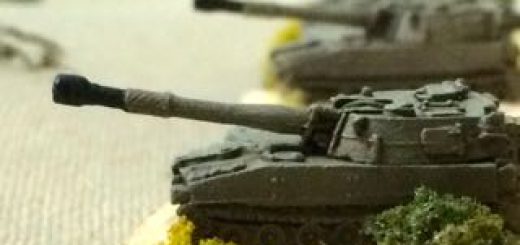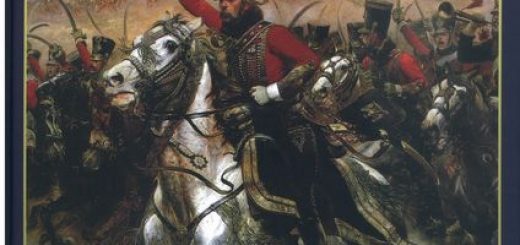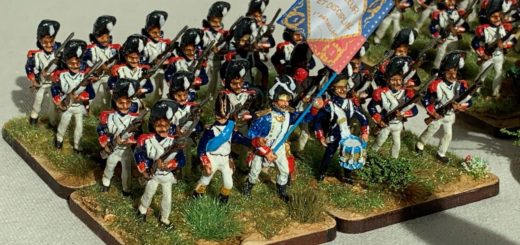Sule colonne russe del 1811
I battaglioni di moschettieri russi del 1811 si organizzano combattono in colonna, per i 2mm, una base di 20X40 mm2, quattro basi su tre ranghi una dietro l’altra. Gli Jager possono andare anche in linea.
La descrizione
We will consider the Army units of the Russians for 1811 and later (some differences apply earlier). The Guard is a very little different also, but generally very similar.
The basic elements for tactical evolutions for the Russians were the “batal’on”/battalion and the “vzvod”/platoon. The “rot”/company was an administrative unit. This organization and the evolutions themselves are really similar to the French use of “bataillon” and “peloton” for tactical evolutions, and the “compagnie” as an administrative unit.
For the Russians, there are 8x “vzvod” in “active” battalions : the 1st Shef’s battalion and the 3rd Commander’s battalion.
For the Combined Grenadier battalions formed from the Grenadier companies of a division’s 2nd Replacement battalions, for these 2nd Replacement battalions themselves, for the 4th Reserve battalion, etc. â in short, for all battalions composed of 3 companies â there were 6x “vzvod”.
For an Infantry regiment as an example (others were the same, with slightly different names of the various parts), the regiment was composed as follows:
1st Shef’s battalion
— 1st Grenadier company : composed of a Grenadier platoon and a Strelkov (or Marksmen) platoon
— 1st Musketeer company : composed of 2 Musketeer platoons
— 2nd Musketeer company : composed of 2 Musketeer platoons
— 3rd Musketeer company : composed of 2 Musketeer platoons
3rd Commander’s battalion
— 3rd Grenadier company : composed of a Grenadier platoon and a Strelkov or Marksmen platoon
— 7th Musketeer company : composed of 2 Musketeer platoons
— 8th Musketeer company : composed of 2 Musketeer platoons
— 9th Musketeer company : composed of 2 Musketeer platoons
2nd Replacement battalion (not used with the “active” battalions)
— 4th Musketeer company : composed of 2 Musketeer platoons
— 5th Musketeer company : composed of 2 Musketeer platoons
— 6th Musketeer company : composed of 2 Musketeer platoons
2nd Grenadier company : composed of a Grenadier platoon and a Strelkov platoon (used in a Combined Grenadier battalion, in the field with the infantry division that included the example regiment)
4th Reserve battalion (inended to be used to move new soldiers from the divisonal recruiting depot to the regiment, actually often used overwise, but separate from the example regiment)
— 1st Recruit company : composed of 2 Recruit platoons
— 2nd Recruit company : composed of 2 Recruit platoons
— 3rd Recruit company : composed of 2 Recruit platoons
For a 1st Shef’s battalion as an example, the platoons deployed as follows :
Strel/1Gren â junior/1Mus â junior/2Mus â junior/3Mus â senior/3Mus â senior/2Mus â senior/1Mus â Gren/1Gren
One would also refer to them by “vzvod”/platoon, as follows:
8th â 7th â 6th â 5th â 4th â 3rd â 2nd â 1st
So that, for example, the junior platoon of the 3rd Musketeer company would be the 5th platoon of the formed battalion.
For Combined Grenadier battalions, recall that they are the Grenadier companies of the 2nd Replacement battalions of 3 regiments of the same division. Each will include 2 grenadier companies from Infantry regiments (a “senior” and a “junior” regiment according to Army regimental senioity) and 1 grenadier company from a Jäger regiment. They are thus composed as follows :
— 2nd Grenadier company of the Jäger regiment : composed of a Grenadier platoon and a Strelkov platoon
— 2nd Grenadier company of the Senior Infantry regiment : composed of a Grenadier platoon and a Strelkov platoon
— 2nd Grenadier company of the Junior Infantry regiment : composed of a Grenadier platoon and a Strelkov platoon
They will deploy as follow :
Strel/Jag â Strel/SenInf â Strel/JunInf â Gren/JunInf â Gren/SenInf â Gren/Jag
One would also refer to them by “vzvod”/platoon, as follows:
6th â 5th â 4th â 3rd â 2nd â 1st
Now, finally, we can get to columns.
I would say that the Russians would often use a column on platoon frontage â either by the right (the 1st vzvod leading) or by the left (the 8th or last vzvod leading). This would be ~22 files. They could also form on a 1/2-platoon frontage for passing obstacles. They even had a rather neat “march by the flank” conversion to a column of three’s.
The had a column formed on the center two platoons (called a “divizion”, as did the French), which if by the right would be:
5th â 4th
6th â 3rd
7th â 2nd
8th â 1st
Naturally, if formed by the left it would be the mirror image. This would be quite similar to a French “colonne d’attaque”, and I think it was the most commonly used formation on divizion frontage for action near the enemy (note that the “elite” platoons can urge the others forward). It saw wide usage at Borodino, for example.
Interestingly, the Shef (usually a general officer) formed with the Gren/1Gren = 1st platoon, but there was a major who would form with the senior/3Mus = 4th platoon.
You could also think of this as looking like as a column of companies in inverse order:
3rd Muskt company
2nd Muskt company
1st Muskt company
1st Gren company
But, as soon as they begin an evolution, the movement is by platoons. And if such a column is formed by the left, the supposed companies have their platoons in the wrong order, and so don’t even look like a correct column of companies.
So, really, the formation and evolutions are by platoon.
They also had this one, also, again shown by the right:
2nd â 1st
4th â 3rd
6th â 5th
8th â 7th
This is like a French “colonne par division” and seems to have been more for ease of movement (the “elite” platoons positioned to help regulate the movement). It can quicky form, or be formed from, a column on platoon frontage.
They also had this odd one, shown again by the right (it is not a mistake : the right-most platoon when deployed ends up leading the left side of the column) :
1st â 8th
2nd â 7th
3rd â 6th
4th â 5th
This had the “elites” in advance. I do get the impression it was not much used, and may have been a parade formation. The evolutions with this column look sharp and snappy, but are very time consuming â like a drill team exhibition. Or maybe it was a “one-way-mission” column (form it once, use it once).
I have heard these books in English are well thought of on Russian tactics, drill and tactical evolutions :
George Nafziger. Imperial Bayonets. link
Alexander & Yurii Zhmodikov. Tactics of the Russian Army in the Napoleonic Wars. http://home.fuse.net/nafziger/CAT.HTM
I have never seen these books â YMMV.
If you know 18th/19th century Russian, I can suggest some other sources for further reading.
All of these columns could form line. However, by the period in question it is not too clear how often they actually did this.
Many know the supposed Suvorov comment “The bullet is a fool, but the bayonet is a fine fellow,” Kutuzov is said to have echoed the sentiment : “Grenadiers and Musketeers â bayonets! Jägers shooting!”
Whether or not the quotes (and translations) are perfectly accurate, there is some truth in the sentiment. Despite lots of practiced evolutions (some quite involved), the Russians of 1812-1814 often tended to use the formed troops for shock, delivered from a column â and the jäger for shooting, delivered as skirmishers.
The Russian fielded 1 jäger for every 2 “heavy” infantrymen â a high ratio.



